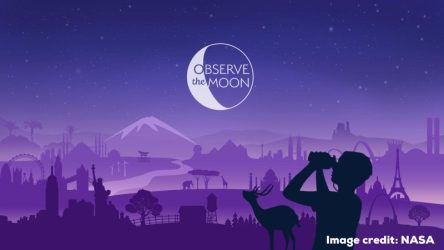 October 1st is NASA’s International Observe the Moon Night (InOMN) event and this month’s blog is devoted to sharing the lunar love all year long.
October 1st is NASA’s International Observe the Moon Night (InOMN) event and this month’s blog is devoted to sharing the lunar love all year long.
InOMN is a NASA sponsored event with the aim of inspiring people from around the world to all look up on this one night of the year in order to not only see the moon but to observe it as well. When was the last time you looked at the moon? And I’m not talking about just noting its presence in the sky that one night while you were driving down the road. I mean, when did you last look at the moon with the same eyes as when you were a child, when you were full of curiosity and wonder and you had so many big ideas, your head seemed too small to ever hold them all in? Can you even remember the last time? The moon is such a rewarding object for observation, it’s a shame that we take its familiar presence for granted.
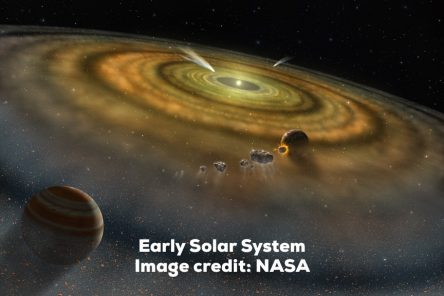 The moon is not only our constant celestial companion, it is also our closest. Its silvery, silent, presence has graced our night skies long before there were people and even before there was life on Earth. The Earth formed some 4.6 billion years ago from out of the miniscule particles of gas and dust that formed a disc around our nascent Sun. This disc of gas and dust were the leftover material from the Sun’s formation and through countless collisions with one another, these particles of gas and dust would eventually snowball and form the planetismals, planets, asteroids, comets, and moons of our solar system. In recent years, with the aid of telescopes such as the Hubble Space Telescope, astronomers have been able to witness this same process occurring at different stages around other, younger, stellar systems. The young Earth kept growing in size by accreting more and more matter through these multiple collisions. It would finally reach its current size through one final cosmic fender bender.
The moon is not only our constant celestial companion, it is also our closest. Its silvery, silent, presence has graced our night skies long before there were people and even before there was life on Earth. The Earth formed some 4.6 billion years ago from out of the miniscule particles of gas and dust that formed a disc around our nascent Sun. This disc of gas and dust were the leftover material from the Sun’s formation and through countless collisions with one another, these particles of gas and dust would eventually snowball and form the planetismals, planets, asteroids, comets, and moons of our solar system. In recent years, with the aid of telescopes such as the Hubble Space Telescope, astronomers have been able to witness this same process occurring at different stages around other, younger, stellar systems. The young Earth kept growing in size by accreting more and more matter through these multiple collisions. It would finally reach its current size through one final cosmic fender bender.
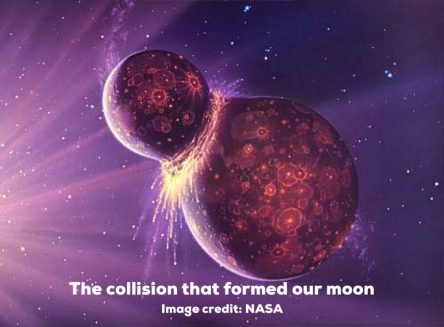 4.5 billion years ago, the solar system is a chaotic place as the various planets, planetismals, asteroids, etc. are all playing bumper car before achieving stable orbits around the Sun. It was amidst all of this pandemonium that a Mars-sized object would collide with the Earth, giving it a glancing blow. The young Earth would absorb much of the offending impactor but some of the vaporized rock and metal from the two bodies was hurled out into space, forming a disc of glowing, superheated matter around the Earth. Yes, our Earth once had a ring! Estimates vary but it is thought that within just one hundred years or less, that ring of molten material would have coalesced under the force of gravity, cooled down, and formed our moon.
4.5 billion years ago, the solar system is a chaotic place as the various planets, planetismals, asteroids, etc. are all playing bumper car before achieving stable orbits around the Sun. It was amidst all of this pandemonium that a Mars-sized object would collide with the Earth, giving it a glancing blow. The young Earth would absorb much of the offending impactor but some of the vaporized rock and metal from the two bodies was hurled out into space, forming a disc of glowing, superheated matter around the Earth. Yes, our Earth once had a ring! Estimates vary but it is thought that within just one hundred years or less, that ring of molten material would have coalesced under the force of gravity, cooled down, and formed our moon.
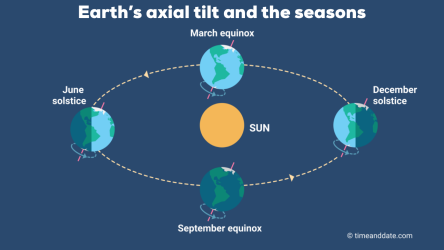
Earth’s current axial tilt of 23.5 degrees is a result of this collision. That tilt is responsible for Earth’s seasons as different hemispheres of the globe receive varying amounts of the Sun’s direct heating as one hemisphere is angled towards the Sun and the other away from it at different times of the year, depending on where the Earth is in its annual trek around the Sun. The moon’s presence is also what keeps the Earth from wobbling like a wildly gyrating top over time. This keeps our climate fairly stable over long periods of time, which is also what makes life, as it exists now, possible.
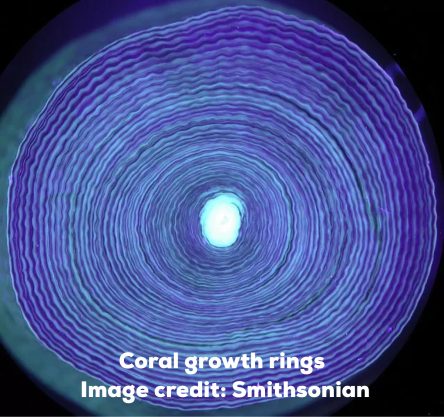
But let’s go back to shortly after the moon’s formation, some 4.53 billion years ago. For a good portion of time, the moon was much closer then than it is today, about half its average distance from Earth (which is about 240,000 miles). Aside from the moon looking ginormous in our night sky, there would have been other consequences. Before the moon formed, a day on Earth is thought to have lasted a mere four hours. Due to the moon’s close proximity, its gravitational braking effect would have slowly lengthened our day to its current value. Do we have any evidence for these shorter days? Yes, we do. Many coral species add thin, fresh layers of calcium carbonate every day to their stony “skeletons” (with a slight slowing during winter), we can calculate how many days growth has occurred over a year by counting these rings. This applies to modern coral as well as to fossil species. When we look at the fossil coral species that thrived early on in life’s history we don’t find 365 days for a year, we find around 400. Granted, these corals existed over a billion years after the moon formed, it was still close enough to wield an influence on Earth’s rotational rate (it still does today), creating longer days. It wouldn’t be until sometime after the Devonian period, some 400 million years ago, that we would eventually reach our current 24-hour day with 365 days for a year.
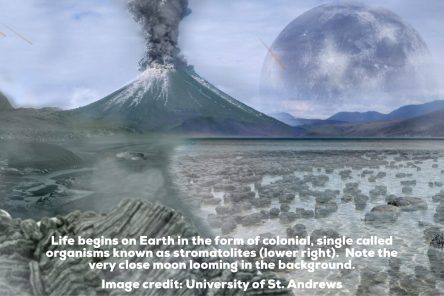
So, what else has the moon done for you lately? More than you might realize. We don’t know exactly how Earth’s pre-biotic chemistry made the leap to full fledged biology but we have pretty good evidence that primitive microbes first appear in the fossil record some 3.7 billion years ago (no, microbes do not fossilize but their life chemistry does leave tell-tale signatures in the rock record). It is not inconceivable that the moon played a hand in this. The moon is the biggest player in raising tides in Earth’s oceans (the Sun and planets do as well but their effects are not as significant). When the moon was much closer, its tidal effects would have been considerably stronger and it is entirely possible that the constant churning effects on our oceans had a hand in the transition from chemistry to life on Earth. We may never know for sure but it is certainly food for thought.
So, life, and the evolutionary processes that shape it, came into being when the moon was still a youngster and its presence probably played but a single tune among the myriad others that evolution has always danced to. Both the moon and the Sun have set the pattern of life’s circadian rhythms, all the physical, mental, and behavioral changes that come from out of living in a 24-hour cycle. Almost all life on Earth has its biological clocks set to the cycles of moon and Sun. Today, we can find a wide variety of plant and animal species whose life cycles and behaviors are intimately tied to the moon. Here are but just a few examples…
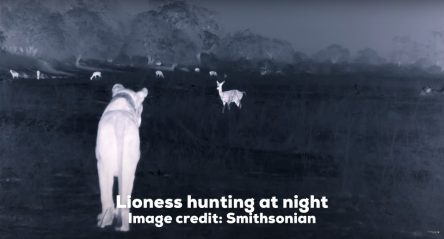 With the aid of a moonlight sensitive protein known as CRY2, many coral species from around the world time their mass emission of eggs and sperm to the light of a full moon.
With the aid of a moonlight sensitive protein known as CRY2, many coral species from around the world time their mass emission of eggs and sperm to the light of a full moon.
In the Mediterranean, there grows a plant known as Ephedra foeminea, which uses the full moon to cue its production of sugary globs that act as pollinator lures. Under the bright moonlight, the sweet treats are said to glitter like diamonds.
Hatchling sea turtles depend on moonlight reflecting off of the ocean surface in order to correctly guide them to the water. (Sadly, artificial lighting kills thousands of baby sea turtles each year by confusing them and misdirecting them inland and away from the relative safety of the sea)
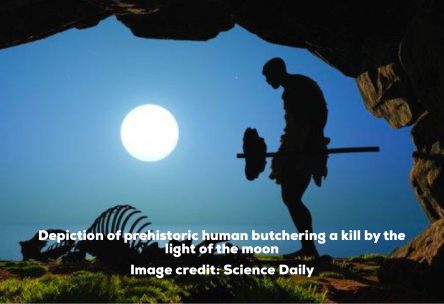
In the constant war between predator and prey, bright moonlight can play a major role as to who gets to eat and who gets eaten. As to who benefits and who does not, it just varies from one species to the next. African lions seem to be adversely impacted by bright moonlight as their hunting success drops on such nights. Presumably, their prey stand a better chance of spotting the lions before they can make a kill. On the other hand, short-eared owls have a much higher success rate at capturing deer mice on bright, moonlit nights.
Around five million years ago, there emerged on the African savannah, a species of upright ape. By 2.5 million years ago, they had evolved to the point where they were flaking rocks to make crude stone tools. When curious apes such as ourselves came along, with all of our curiosity and wonder, we began to ask ourselves questions about the moon. What is it? Why is it there? Why is it always changing its face? What is it made of? How far away is it? By asking and trying to answer those questions, we came to create myths. We even drew creative inspiration from the moon, driving us to tell stories, paint pictures, as well as write music and poetry. We also observed and learned. Some of the takeaway knowledge that we gained proved to have practical applications. For example, by noting how many days it always took for the moon to go through a full set of phases, we came up with the idea for something we called a “moonth” or “month”, as all the kids are calling it these days. When we made the big leap from being nomadic hunter/gatherers to that of agrarian farmers we learned how to keep track of long periods of time from our close observations of the cycles and rhythms of Sun, moon and stars. We created things like sundials and calendars so that we could look forward in time in order to know when to plant and harvest crops or to look back in time in order to honor and commemorate important dates in our past. In short, we were on our way towards building a civilization.
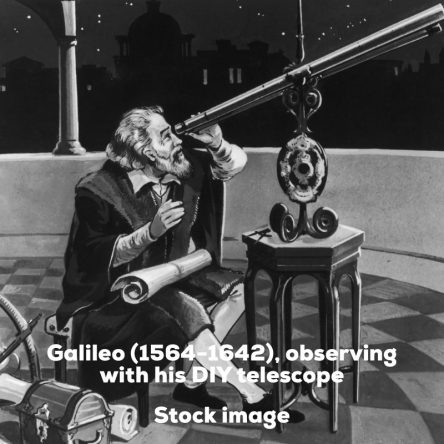 As time went on, our curiosity only grew and after about 1,500 years of just looking and wondering, we were finally able to take matters in hand by inventing crude telescopes. At that point the moon became not just an object, but a destination. We have always been wanderers and explorers and nearly 400 years after we began building telescopes we began to build rockets. True, our primitive primate brains initially only wanted to use rockets in order to bring death and destruction to our neighbors and their children, but some of us were looking ahead and thinking how we could use these terrible weapons as a means to reach for something higher and more noble than murder. It wasn’t long before we finally stepped out into space and walked upon the surface of another world, the moon. In doing so, much of the technology we needed to invent in order to carry human beings there and back again, would turn out to have broader applications, applications that would forever change the world around us and how we interact with one another. For example, the need to create light, compact computers for the Apollo spacecraft led NASA to use the then relatively new technology, the integrated circuit, which packed multiple transistors onto a silicon chip, paving the way for its future use in a variety of emergent technologies. The device you are now reading this on is the descendant of such technology, born out of the fact that we have always been looking up at the moon, for so long, and driven by so many questions we wanted answers to.
As time went on, our curiosity only grew and after about 1,500 years of just looking and wondering, we were finally able to take matters in hand by inventing crude telescopes. At that point the moon became not just an object, but a destination. We have always been wanderers and explorers and nearly 400 years after we began building telescopes we began to build rockets. True, our primitive primate brains initially only wanted to use rockets in order to bring death and destruction to our neighbors and their children, but some of us were looking ahead and thinking how we could use these terrible weapons as a means to reach for something higher and more noble than murder. It wasn’t long before we finally stepped out into space and walked upon the surface of another world, the moon. In doing so, much of the technology we needed to invent in order to carry human beings there and back again, would turn out to have broader applications, applications that would forever change the world around us and how we interact with one another. For example, the need to create light, compact computers for the Apollo spacecraft led NASA to use the then relatively new technology, the integrated circuit, which packed multiple transistors onto a silicon chip, paving the way for its future use in a variety of emergent technologies. The device you are now reading this on is the descendant of such technology, born out of the fact that we have always been looking up at the moon, for so long, and driven by so many questions we wanted answers to.
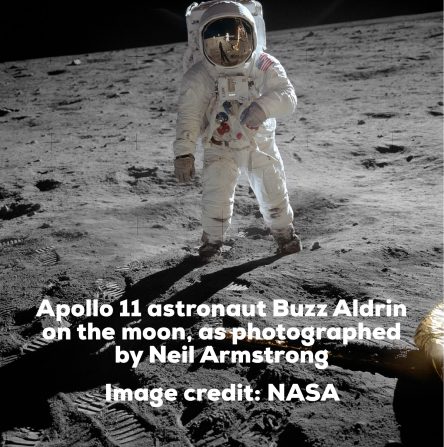 And while there is no argument that our first mission to the moon was born out of a Cold War rivalry, there can also be no argument for the good will and sense of global unification the event engendered, if only for a short time. Michael Collins, the Apollo 11 command module pilot, often stated that while on the global good will tours that followed, people would say things like “WE did it!”, not “You Americans”. Prior to the Apollo 11 moon landing, on Christmas Eve, 1968, the crew of Apollo 8 took a photo of the fragile-looking Earth suspended in space. It was called “Earthrise” and it became one of the most iconic images of the 20th century, sparking the rise of a global environmental movement. That’s why it is so vitally important that we never stop looking up with awe, wonder, and curiosity. These are the things that unite us and that drive us to do great things.
And while there is no argument that our first mission to the moon was born out of a Cold War rivalry, there can also be no argument for the good will and sense of global unification the event engendered, if only for a short time. Michael Collins, the Apollo 11 command module pilot, often stated that while on the global good will tours that followed, people would say things like “WE did it!”, not “You Americans”. Prior to the Apollo 11 moon landing, on Christmas Eve, 1968, the crew of Apollo 8 took a photo of the fragile-looking Earth suspended in space. It was called “Earthrise” and it became one of the most iconic images of the 20th century, sparking the rise of a global environmental movement. That’s why it is so vitally important that we never stop looking up with awe, wonder, and curiosity. These are the things that unite us and that drive us to do great things.
So, the next time you gaze up at the moon, I hope you do so with a newfound sense of appreciation for our closest celestial neighbor. The world next door has truly played a significant role in shaping the one that you and I live on and, for me, it will always be a continual source of awe and wonder.